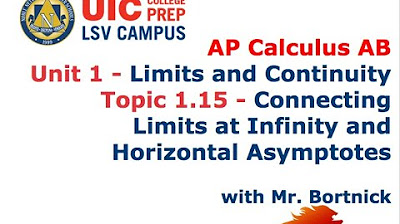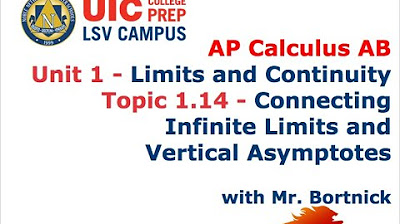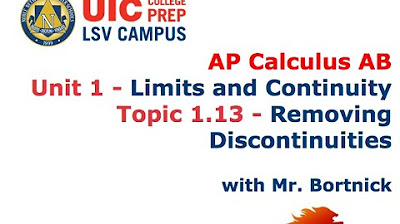AP Calculus AB - Chapter 1 Review - Part 2
TLDRMr. Bortnick's AP Calculus AB review covers Unit 1, focusing on limits and continuity from sections 1.10 to 1.16. He explains how to identify discontinuities, assess function continuity, and find domains. The instructor also discusses vertical and horizontal asymptotes, including special cases and their implications. Techniques for evaluating limits at infinity and determining function values at specific points are provided, with an emphasis on understanding the underlying calculus concepts for successful problem-solving.
Takeaways
- 📚 The video is a review session for AP Calculus AB, focusing on Unit 1, specifically sections 1.10 through 1.16, following a mid-unit review of sections 1.1 through 1.9.
- 🔍 Mr. Bortnick emphasizes the importance of reviewing all packets and notes from Unit 1, including the previously discussed mid-unit review, to prepare for the upcoming test.
- 📈 The review covers how to identify types of discontinuities in functions, such as removable discontinuities (holes) and vertical asymptotes, by looking for values that make the denominator zero.
- 📝 The script explains the criteria for a function to be continuous at a point: the function value exists, the limit exists, and the function value equals the limit.
- 🧩 The domain of a function is discussed, highlighting that it includes all x-values where the function is defined, excluding those that make the denominator zero or make the expression undefined (like under a square root).
- 🔢 For a function to be continuous at a specific point, the value of the function at that point and the limit as x approaches that point must be equal, which is a key concept for understanding continuity.
- 📉 The video provides examples of finding the domain of piecewise functions and rational functions, noting the restrictions on x-values due to the denominator and the need for expressions under square roots to be non-negative.
- ∞ When discussing limits as x approaches infinity, the script focuses on the behavior of the function, specifically whether it tends towards positive or negative infinity or towards a specific value, indicating horizontal asymptotes.
- 📌 The concept of vertical asymptotes is explored, showing how they occur when the denominator of a rational function is zero, and the function's behavior as x approaches the point of the asymptote.
- 📶 The review also touches on how to handle special trigonometric limits and the importance of recognizing the difference between limits as x approaches zero and as x approaches infinity.
- 📝 Lastly, the script concludes with a reminder to study thoroughly for the upcoming test and offers assistance for any questions, emphasizing the importance of understanding the material for success in the exam.
Q & A
What is the main focus of the second part of the Unit One review in the video?
-The second part of the Unit One review focuses on sections 1.10 through 1.16 of the AP Calculus AB course, covering topics such as limits and continuity.
What are the three key conditions for a function to be continuous at a point x=c?
-For a function to be continuous at x=c, three conditions must be met: 1) f(c) must exist, 2) the limit as x approaches c of f(x) must exist, and 3) the limit as x approaches c of f(x) must be equal to f(c).
What is the difference between a removable discontinuity and a vertical asymptote?
-A removable discontinuity, also known as a hole, occurs at a point where the function is not defined but the limit exists. A vertical asymptote occurs where the function is not defined and the limit does not exist, causing the graph to approach infinity or negative infinity as it approaches that point.
How does the video determine the discontinuity of the function f(x) = (x + 3) / (x^2 - 2x - 15)?
-The video determines discontinuity by factoring the denominator, identifying values of x that make the denominator zero, and checking for cancellation with the numerator. A hole is identified at x = -3, and a vertical asymptote at x = 5.
What is the domain of a function where the denominator cannot equal zero and there is a square root in the numerator?
-The domain excludes values that make the denominator zero and also ensures that the expression under the square root in the numerator is greater than or equal to zero.
How does the video find the value of b for which the function is continuous at x = -6 in the piecewise function given in the script?
-The video identifies that for continuity at x = -6, the removable discontinuity must be filled. By factoring and simplifying the function, it is determined that b must equal -4 to fill the hole and make the function continuous at that point.
What is the limit as x approaches infinity for the function f(x) = (3πx^2 + x) / (2x^2)?
-The limit as x approaches infinity for this function is 3π/2, as the x^2 terms cancel out and the leading term 3πx^2 dominates over the constant 3π.
How does the video approach finding the limit as x approaches negative one for the function f(x) = (x^2 + 1) / (x + 1)?
-The video evaluates the limit from both the left and right sides of x = negative one, comparing the results to determine if the overall limit exists. It finds that the limit from the left is negative infinity and from the right is positive infinity, concluding that the overall limit does not exist.
What is the domain of the natural logarithm function in the script?
-The domain of the natural logarithm function excludes values that make the argument zero or negative, as the logarithm is only defined for positive numbers.
How does the video identify horizontal asymptotes for the function f(x) = √(16x^6 + x^3 + 5x) / (5x^3 - 8x)?
-The video identifies horizontal asymptotes by considering the limits as x approaches both positive and negative infinity, focusing on the highest exponent terms and their ratios.
Outlines
📚 Chapter One Review: Limits and Continuity
Mr. Bortnick's video script covers the second part of the Unit One review for AP Calculus AB, focusing on sections 1.10 through 1.16. It emphasizes the importance of reviewing all unit materials, including the mid-unit review, to refresh key points on limits and continuity. The script provides a detailed analysis of discontinuity types, such as holes and vertical asymptotes, using the function f(x) = (x + 3) / (x^2 - 2x - 15) as an example. It also explains the criteria for a function to be continuous at a point, highlighting the need for the function to exist, the limit to exist, and the limit to equal the function's value at that point.
🔍 Continuity Assessment and Domain Determination
The script delves into the assessment of function continuity at specific points, using piecewise functions as examples. It outlines the process of checking if the function value exists, the limit from both sides, and whether the limit equals the function value at the point of interest. The domain of functions is discussed, with the script explaining how to identify values that make the denominator zero and how to express the domain in interval notation. The importance of understanding the behavior of functions at the boundaries of their domain is highlighted.
🔧 Continuity and Function Definition at Specific Points
The video script explores the concept of continuity further by examining the continuity of a function at x = -2, given a piecewise definition. It demonstrates how to determine the value of the function at a point where the function is not directly defined by factoring and simplifying the expression. The process involves canceling out terms and evaluating the simplified function at the point in question, ensuring the function is well-defined and continuous at that point.
📉 Limits and Asymptotes: Approaching Infinity
The script discusses the evaluation of limits as x approaches infinity, focusing on horizontal and vertical asymptotes. It provides examples of how to identify the behavior of functions as x becomes very large, either positively or negatively. The explanation includes the simplification of expressions by focusing on the terms with the highest exponents and understanding how these terms dictate the function's behavior at infinity. The script also corrects a previous statement about a horizontal asymptote, emphasizing the importance of careful analysis.
📌 Limits at Specific Values and Asymptote Analysis
This section of the script addresses the evaluation of limits as x approaches specific values, such as negative one, and the identification of vertical asymptotes. It explains the process of finding limits from both the left and right sides of a point and discusses the implications when these limits do not match, indicating that the overall limit does not exist. The script also provides a method for determining whether a function approaches positive or negative infinity as x approaches a certain value.
📈 Horizontal Asymptotes and Limit Behavior at Infinity
The final part of the script reviews the identification of horizontal asymptotes and the behavior of limits as x approaches both positive and negative infinity. It explains the importance of considering the leading terms of a fraction when determining horizontal asymptotes and provides a detailed example of how to calculate these asymptotes. The script also emphasizes the need to consider the direction of infinity (positive or negative) when evaluating limits, as this can result in different asymptotes.
📘 Conclusion and Study Tips for Upcoming Test
In conclusion, the script wraps up the review of Chapter One, offering study tips and encouragement for the upcoming test. It advises students to study diligently and reach out with any questions. The script ends on a positive note, wishing students good luck on their test and thanking them for their engagement with the material.
Mindmap
Keywords
💡Discontinuity
💡Continuity
💡Domain
💡Vertical Asymptote
💡Removable Discontinuity
💡Limit
💡Horizontal Asymptote
💡Piecewise Function
💡Factor
💡Trigonometric Functions
💡Exponential Functions
Highlights
Introduction to Unit One Review on Limits and Continuity, focusing on sections 1.10 through 1.16.
Explanation of discontinuity types, including holes and vertical asymptotes, with an example function.
The importance of reviewing all packets and notes from Unit 1 for the chapter review.
Three conditions for a function to be continuous at a point: existence of f(c), limit as x approaches c, and equality of both.
Analysis of function continuity at x equals zero using the three conditions for continuity.
Determination of function continuity at x equals pi/4, showcasing the limit from both left and right sides.
Finding the domain of a function by identifying values that make the denominator zero and considering the square root's requirements.
Continuity of a function at x = -2, given the function's definition and handling of the denominator.
Determining the value of b for a piecewise function to be continuous at x = -6 by filling a removable discontinuity.
Evaluating limits as x approaches infinity, focusing on the largest exponent terms for horizontal and vertical asymptotes.
Identification of horizontal asymptotes for a function by comparing the degrees of the numerator and denominator polynomials.
Approach to limits involving trigonometric functions and infinity, emphasizing the oscillation between 1 and -1.
Explanation of vertical asymptotes and their implications on the behavior of a function as x approaches a certain value.
Analysis of limits with exponential functions in the denominator compared to polynomial functions in the numerator.
Identification of all horizontal asymptotes for a given function, considering both positive and negative infinity.
Conclusion of the chapter one review, emphasizing the importance of studying for the upcoming test.
Transcripts
Browse More Related Video

AP Calculus AB - 1.15 Connecting Limits at Infinity and Horizontal Asymptotes

AP Calculus AB - 1.14 Connecting Infinite Limits and Vertical Asymptotes

AP Calculus AB Unit 1 Review | Limits and Continuity

AP Calculus AB - 1.13 Removing Discontinuities

AP Calculus AB - 1.5 Determining Limits Using Algebraic Properties of Limits

Math 1325 Lecture 9 2 - Continuous Functions & Limits at Infinity
5.0 / 5 (0 votes)
Thanks for rating: